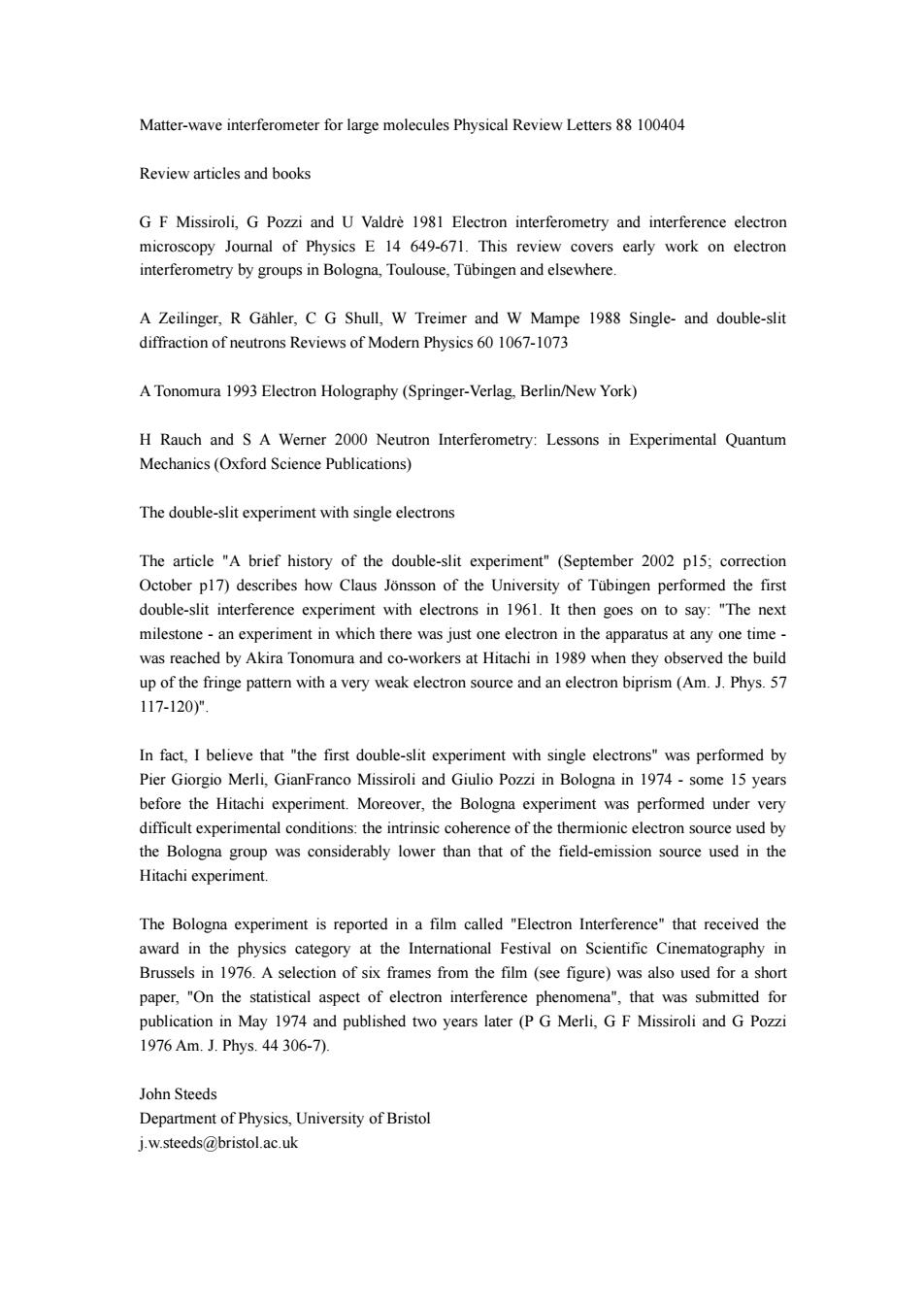正在加载图片...

Matter-wave interferometer for large molecules Physical Review Letters 88 100404 Review articles and books G F Missiroli,G Pozzi and U Valdre 1981 Electron interferometry and interference electron microscopy Journal of Physics E 14 649-671.This review covers early work on electron interferometry by groups in Bologna,Toulouse,Tubingen and elsewhere. A Zeilinger,R Gahler,C G Shull,W Treimer and W Mampe 1988 Single-and double-slit diffraction of neutrons Reviews of Modern Physics 60 1067-1073 A Tonomura 1993 Electron Holography (Springer-Verlag,Berlin/New York) H Rauch and S A Werner 2000 Neutron Interferometry:Lessons in Experimental Quantum Mechanics (Oxford Science Publications) The double-slit experiment with single electrons The article "A brief history of the double-slit experiment"(September 2002 p15;correction October pl7)describes how Claus Jonsson of the University of Tubingen performed the first double-slit interference experiment with electrons in 1961.It then goes on to say:"The next milestone-an experiment in which there was just one electron in the apparatus at any one time- was reached by Akira Tonomura and co-workers at Hitachi in 1989 when they observed the build up of the fringe pattern with a very weak electron source and an electron biprism(Am.J.Phys.57 117-120)" In fact,I believe that "the first double-slit experiment with single electrons"was performed by Pier Giorgio Merli,GianFranco Missiroli and Giulio Pozzi in Bologna in 1974-some 15 years before the Hitachi experiment.Moreover,the Bologna experiment was performed under very difficult experimental conditions:the intrinsic coherence of the thermionic electron source used by the Bologna group was considerably lower than that of the field-emission source used in the Hitachi experiment. The Bologna experiment is reported in a film called "Electron Interference"that received the award in the physics category at the International Festival on Scientific Cinematography in Brussels in 1976.A selection of six frames from the film(see figure)was also used for a short paper,"On the statistical aspect of electron interference phenomena",that was submitted for publication in May 1974 and published two years later(P G Merli,G F Missiroli and G Pozzi 1976Am.J.Phys.44306-7). John Steeds Department of Physics,University of Bristol j.w.steeds(@bristol.ac.ukMatter-wave interferometer for large molecules Physical Review Letters 88 100404 Review articles and books G F Missiroli, G Pozzi and U Valdrè 1981 Electron interferometry and interference electron microscopy Journal of Physics E 14 649-671. This review covers early work on electron interferometry by groups in Bologna, Toulouse, Tübingen and elsewhere. A Zeilinger, R Gähler, C G Shull, W Treimer and W Mampe 1988 Single- and double-slit diffraction of neutrons Reviews of Modern Physics 60 1067-1073 A Tonomura 1993 Electron Holography (Springer-Verlag, Berlin/New York) H Rauch and S A Werner 2000 Neutron Interferometry: Lessons in Experimental Quantum Mechanics (Oxford Science Publications) The double-slit experiment with single electrons The article "A brief history of the double-slit experiment" (September 2002 p15; correction October p17) describes how Claus Jönsson of the University of Tübingen performed the first double-slit interference experiment with electrons in 1961. It then goes on to say: "The next milestone - an experiment in which there was just one electron in the apparatus at any one time - was reached by Akira Tonomura and co-workers at Hitachi in 1989 when they observed the build up of the fringe pattern with a very weak electron source and an electron biprism (Am. J. Phys. 57 117-120)". In fact, I believe that "the first double-slit experiment with single electrons" was performed by Pier Giorgio Merli, GianFranco Missiroli and Giulio Pozzi in Bologna in 1974 - some 15 years before the Hitachi experiment. Moreover, the Bologna experiment was performed under very difficult experimental conditions: the intrinsic coherence of the thermionic electron source used by the Bologna group was considerably lower than that of the field-emission source used in the Hitachi experiment. The Bologna experiment is reported in a film called "Electron Interference" that received the award in the physics category at the International Festival on Scientific Cinematography in Brussels in 1976. A selection of six frames from the film (see figure) was also used for a short paper, "On the statistical aspect of electron interference phenomena", that was submitted for publication in May 1974 and published two years later (P G Merli, G F Missiroli and G Pozzi 1976 Am. J. Phys. 44 306-7). John Steeds Department of Physics, University of Bristol j.w.steeds@bristol.ac.uk